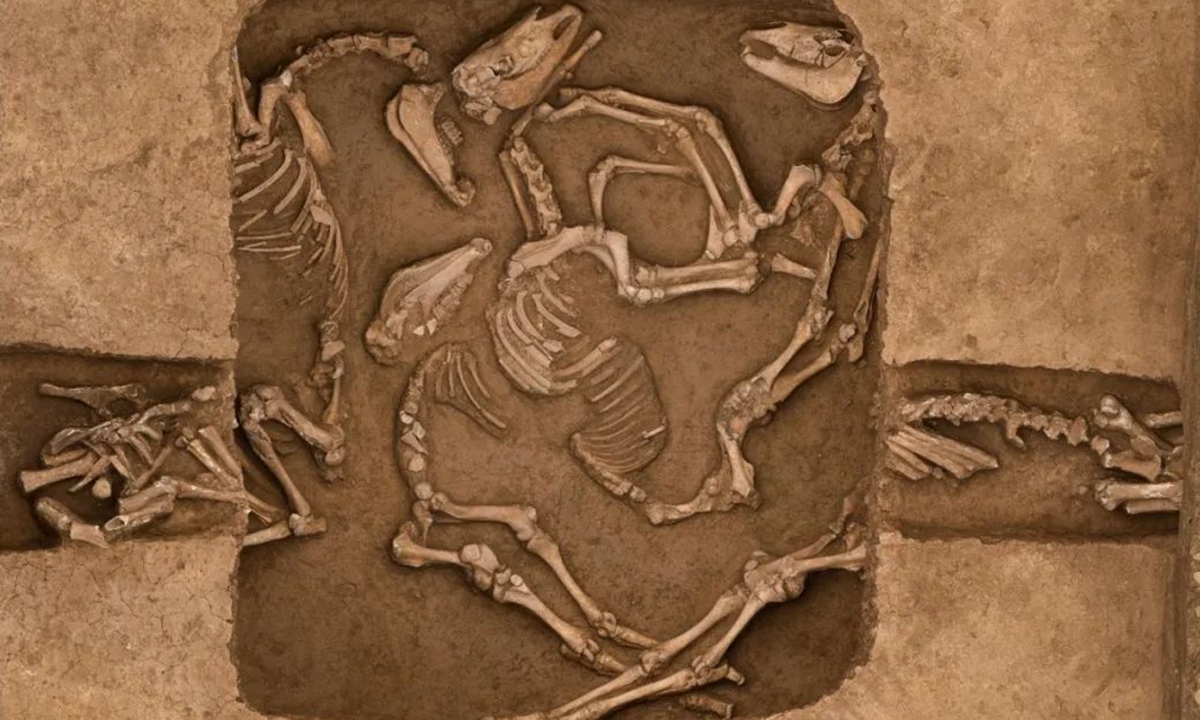New Discoveries at Shaanxi Site Give Insight into Qin and Han Sacrificial Culture

Photo: Courtesy of You Fuxiang
Some new discoveries have been made at the Xiazhan Ruins archaeological site in Baoji, Northwest China's Shaanxi Province. A large number of animal skeleton remains in its sacrificial pits make the site a best-preserved evidence of the Qin (221BC-206BC) and Han (206BC-AD220) dynasties' sacrificial culture.
The Xiazhan Ruins were an ancient "mizhi," a sacrificial site once used by ancient people for worshiping Heaven, or more accurately, it was used to "worship Fuxi during the Qin period," You Fuxiang, the archaeological project's lead and deputy director of the Institute of Archaeology of the National Museum of China, told the Global Times. In Chinese mythology, Fuxi is the first ancestor of mankind. Although the Xiazhan Ruins were identified as a sacrificial site during the first excavation at the site in 2020, nine newly unearthed sacrificial pits have shown how has this role lasted over the centuries.
The newly discovered pits, rectangular in shape, have been divided into A and B pits.
The bones of cattle and sheep were buried in the A pits. These remains date back to the middle- and late-Spring and Autumn Period (770BC-476BC). The B pits were filled with scattered horse bones. The two types of pits and their remains show that the site was used for sacrifices from the "Spring and Autumn Period to the late Western Han Dynasty [206BC-AD25] ," You told the Global Times. "This extended time period allows us to see the continuity and development of the sacrificial culture at the site since the pre-Qin period," explained You. He added that the quantity of animal sacrifices in the pits were considerable. For example, around 70-80 animal skeletons have been found in just one of the site's pits. As of 2024, more than 1,400 sacrificial pits have been unearthed.
Besides the animal pits, the Xiazhan Ruins are a treasure trove of other relics. In 2023, a large number of artifacts made of jade, gold and bronze were unearthed. Two human-shaped jade figurines and a jade cong, a tall, rectangular ritual object, are some of the star items among the discovered artifacts. Chariot-shaped artifacts and military tools made of gold and bronze were also unearthed.
He Jierao, an expert who specializes in Qin Dynasty archaeology, told the Global Times that these finds reflect "the emphasis placed on the chariot and horse system as well as military culture of the Qin and Han dynasties."
Besides artifacts made of precious materials, a pottery ware unearthed from the site is of significance since it gives insight into where the sacrificial tools used at the site where made. The pottery was stamped with the character "mi" for the "mizhi" sacrificial system. You told the Global Times that the stamp is evidence that these wares "were made in Chang'an (today's Xi'an) by the imperial sacrificial department of the Qin dynasty and were then transported to Baoji." "These items show ancient Chinese sacrificial culture not only involved people's spiritual reverence for Heaven, but also carried realistic values guiding social activities," he told the Global Times. Since 2020, a total of four excavations have been carried out at the Xiazhan Ruins. "The site is currently the most clearly defined, longest-lasting, and best-preserved imperial-level sacrificial site. It was continuously used for more than 600 years in ancient China," You emphasized.

Photo: Courtesy of You Fuxiang